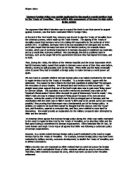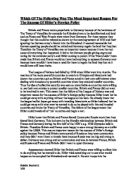While the provisions of the agreement were never fully carried out it is important to understand that Germany, was not subservient to Great Britain, certainly attempted to reduce tensions, even to the point of an alliance against France. By 1936, Hitler had successfully brought Germany closer to Great Britain using many valuable diplomatic techniques. Great Britian was not the only country to be appeased by Nazi Germany. Italy, too, was an important link in Nazi foreign policy. Hitler knew that Germany could not survive another two and possibly three front war. Hitler was forced to give up one or more of these borders, and gain an alley as well. He chose Italy. Italy had been fascist since 1921, and had grown tremendously since then. Hitler also knew that Italy was strong enough to hold its own, but not strong enough to make a difference in the coming war, if the actions of World War I were repeated. In 1936, the two leaders Hitler and Benito Mussolini, met and signed what was called the Axis Agreement. According to the agreement, Rome and Berlin were the strongest cities in Europe, and therefore acted as an axis for all other powers to revolve around. This treaty was a loose agreement, which held the two countries together until the Pact of Steel was signed in1939.
Hitler, here, alleviated any possibility of there being a southern front. There were more than political reasons that Germany was appeasing towards Italy. The two nations had a type of brotherhood, thanks to their leaders. Mussolini had been the fascist leader of Italy for 12 years and his system became the blueprint for Hitler’s system. The two leaders felt connected, being two fascist leaders in a world of communists and capitalists. Hitler learned how to effectively run a fascist regime. An example of this is when Germany began to invade Austria in 1934, and Italian troops marched along the Brenner Pass and pushed them back. Hitler tested his limits and Mussolini proved Italy’s power. Germany made sure not to increase tensions too much. German-Italian relations were very important to Hitler because Italy was the perfect candidate for an alliance, which explains his emphasis on peaceful policies.
Nazi Germany was faced with the same dilemma that pre-World War I leaders were, encirclement. The Germans were faced with the French on the west, and the Russians on the east, To alleviate this problem was to form some sort of alliance with one of the two. A Fraco-German alliance was completely out of the question, the two nations were too culturally different. Hitler was then faced with the need to appease the USSR. The Weimer government had began such a process in the Treaty of Rapallo. In this treaty, both counties received what they needed most, for Germany it was jobs and a place to sell goods, and for the USSR is was a reliable source of quality goods. Hitler felt that that it was completely necessary to continue this treaty for two main reasons. The first reason was that the Germans needed a place to train their men. Under the Treaty of Versailles, Hitler could not train large amounts of men with new technology in Germany. Hitler sent troops over to the USSR, where they would train using both Soviet and German technology. In this way, the treaty would still be kept, and the German military would not be outdated. The second reason was caused by the alliance with Great Britain. Hitler felt that is would be impossible to simultaneously seek an alliance with Great Britain while also trying to win colonies. Germany need new territory and resources for her surplus population, and without colonies, this would be impossible. Hitler came up with a solution, which would give Germany her needed living space. Hitler proposed to seek living space in the USSR. By doing this, he felt, Germany would not only have an outlet for people, soldiers, and goods, but also it would bring the two nations together.
Germany was also faced with the problems that the Weimar Government was faced with. The biggest of these was the Treaty of Versailles. Not only did the treaty both humiliate and put to shame Germany, but also it devastated them economically. One of the first things that the Nazi government did in 1933 was begin to free Germany from this treaty. The treaty stated that the German land army could only consist of 100,000 men. This was very few compared to Germany’s neighbors, which had millions of troops at their disposal. Hitler found a way to get around this, and it was by having men who wanted to join the German army, join the SA or the SS. These armies were not technically the German army, so the actual German army did have less than the amount stated. Another way that Hitler began to nullify the treaty was to regain land lost by it. Two examples of this are the Saar mines and the Rhineland. After the Treaty of Versailles, Germany lost both of these area and since 1919 the German people wanted them back. The Saar mines were extremely productive coalmines and the Rhineland was a fertile area used by Germany. When Hitler regained both of these areas he (Germany) was in direct violation of the treaty. This was part of Hitler’s plan to make Germany strong, his priority was to make Germany a world power. The treaty of Versailles hurt Germany militarily, but more importantly, it hurt them economically. Germany was forced to pay for the entire war, which was an incredible high amount, in which it could not possibly repay. The Weimer government struggled a great deal, having to struggle through the crisis of 1923, were the French demanded payment that Germany just did not have. When the Nazis took control in 1933, it was a very different story. The Nazi had no binding obligation to the treaty. Hitler did not sign the Treaty of Versailles, neither did any Nazi, so it was generally felt that they should hot have to conform their government to fit it. Even with the help of the Dawes Plan and the Young Plan the debt was far too much for Germany to pay, so Hitler refused to pay it. He stated that the Weimar government signed for the debt, and that the treaty died with the Weimar government.
The government of Nazi Germany was not a popular one, internationally speaking. In 1933, the British, French and the Americans openly stated their discomfort in the Nazi seizure of power, this becomes a serious problem for Hitler. Without allies, the Nazis would surely fail. It is here that Hitler used his diplomatic skills to make other countries forget the past. Hitler began with Great Britain, encouraging British rearmament, along with fortifying Great Britain’s understanding that they possessed the strongest navy in Europe. Hitler did the same with Italy, wooing them with the possibility of Germany and Italy taking over Europe. It was also clear that Hitler needed an ally to the east, and therefore began to ally with the USSR. Although his attitude changed, and many of his “allies” became enemies, there was one country whose fate was never in question, France. Hitler and all Germans were French-phobic due to the seizure of German lands in the Treaty of Versailles. Germany before 1936 had a one-track foreign policy that was required under the circumstance. It consisted of friendliness towards former enemies, Great Britain, the USSR, and Italy. Even though Hitler’s policy was one of appeasement, it more often was a planned gamble. So many problems faced the Nazis, they were forced to take a divide and conquer attitude in both foreign and domestic policy. The new Nazi government had a tremendous amount of domestic issues to deal with up until 1936, and the foreign policy that was issued was the best time saver possible. The Nazis successfully gained control of the country and at that time, the policy became the opposite, one of complete aggression, finally leading to World War II. The foreign policy was a prelude to the aggressive, militaristic policy of the Nazis after 1936. I believe that that the war could have been prevented had Neville Chamberlin, the British Prime minister not been so afraid of war. If he had confronted Hitler earlier and stopped tying to appease him it would have stopped Hitler in his tracks.
If the reparations against Germany with the Treaty of Versailles weren’t so astronomical maybe the revenge that the Allies took on Germany wouldn’t have came back to haunt them. A gentleman on the English Board of Trade gave Hitler a loan to try and buy peace. Yet the money when to defense building instead of war reparations. Chamberlin also didn’t take Hitler’s threat to attack Czechoslovakia seriously. It seemed that Chamberlin sacrificed Czechoslovakia in order to save his own country. Instead of meeting Hitler halfway on the Czech issue he practically bowed at Hitler’s feet having already worked out the arrangements for the transfer of territory when they met at Godesbar. Hitler’s zeal to obtain more territory could have also been squashed in the Munich Agreement. After Hitler’s refusal to stop acquiring more territory Britain, France or the US could have made some arrangements to retaliate in Germany buy sanctions.
Daniel McCabe







